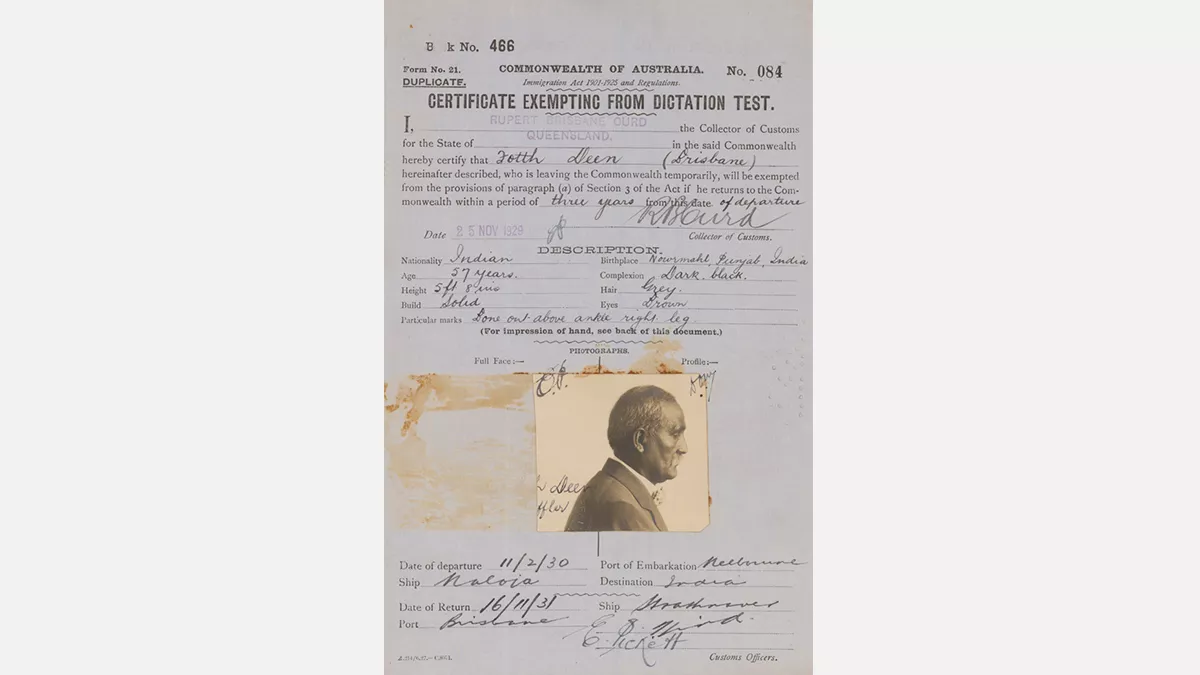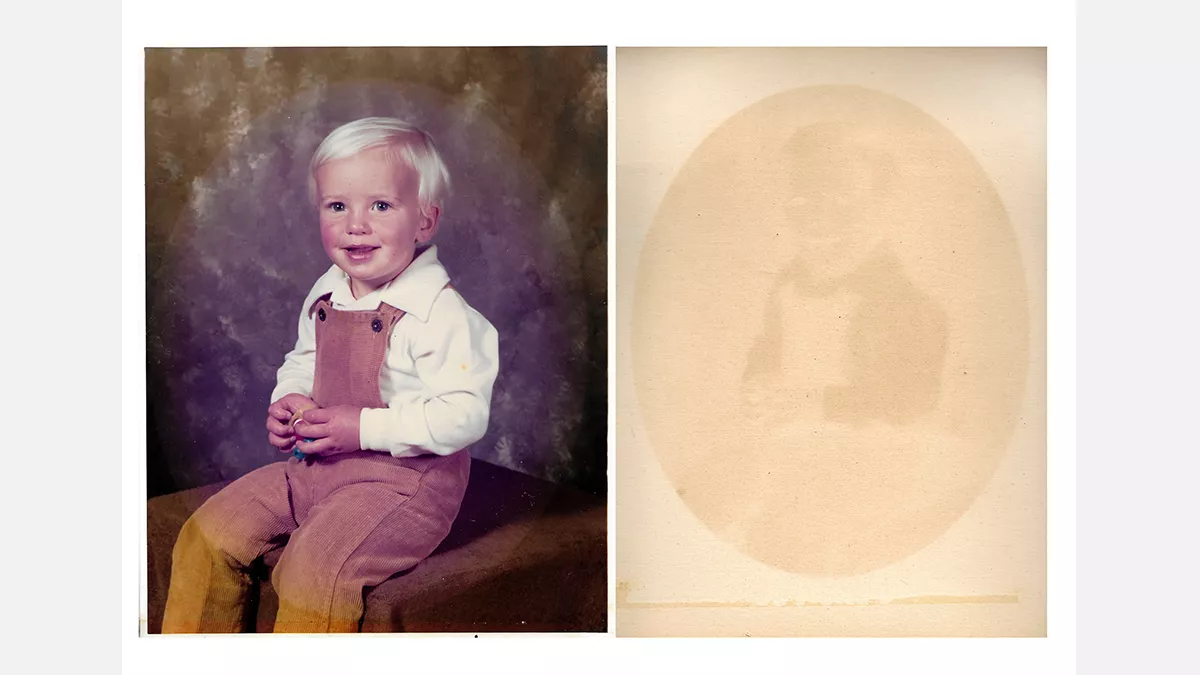‘Between Worlds’ – online exhibition
'Between Worlds' explores the migrant experience in Australia. Through four distinct bodies of work, the artists examine language, expectations, overlooked stories and family archives to illuminate the fears and struggles that come with forming a new home.
Deconstructing themes of belonging, identity and bias through photography, painting, collage and mixed media, 'Between Worlds' offers a window into the complex myriad of experiences held by migrants in the Boroondara community and beyond.
This exhibition is proudly hosted by Boroondara Arts to coincide with and celebrate Harmony Week.
Featuring: Jorge Rodrigo Ceballos, Yask Desai, Heather Felix, Andres Murcia, Susie Raz and Simone Schroeder.
Many of the artworks in this exhibition are for sale. Visit our shop to purchase an artwork.
Yask Desai
Yask Desai’s series ‘Telia’ examines the experiences of the men who migrated from undivided India and worked as hawkers or travelling salesmen within rural Australia during the late 19th and early to mid-20th centuries. Their purpose for migrating was to earn money from the extended families they left behind. Telia was the name given to Australia by some family members who remained in India.
Employing found documents to establish the historical background impacting these men, Desai’s work extracts their personal narratives: the hardships they faced and enduring generational legacies.
Far from being a forgotten or bygone chapter in Australian history, the lives of the men who worked as hawkers enable an examination and reinterpretation of the ongoing colonial project in Australia. ‘Telia’ illustrates how the experiences of past generations directly affect and influence the lives and stories of those who follow.


In the decades after men began migrating to Australia from India, the Immigration Restriction Act 1901 was introduced. Also known as the White Australia policy, it significantly impacted non-European migration between 1901 and 1958. A dictation text of 50 words was one of the primary ways this Act was implemented. Presiding customs officers could choose to give the test in any European language. Anyone who failed could be immediately deported under the Act. Non-Europeans who became Australian residents prior to and during this Act could obtain a Certificate of Exemption of Dictation Test. This certificate meant men who travelled to visit family in India were not required to sit a dictation test upon their return to Australia.


Price on application

Price on application
When Beechworth Cemetery was established in 1856, it was laid out in sections split and delegated to prominent Christian churches in the area. Non-Christian residents or those whose religion was unknown were buried in the ‘strangers’ section. There lie the headstones of Dalale Singh Gill and Sunda Singh, who worked as hawkers in the Beechworth area. They were first buried and later exhumed and cremated as per their Hindu tradition.

Price: $400

Price: $400


Price on application
Sucha Singh Sihota is the grandson of Hukam Singh, who worked as a hawker in Leitchville, New South Wales. Hukam Singh periodically repatriated money to India earnt from hawking in Australia. Using this money, Singh’s family built a house in his native village of Barapind in Punjab. Hukam Singh’s great-grandson and great-granddaughter in law still live in the house. A photograph of Hukam Singh still hangs in Sucha Singh Sihota’s house in nearby Jalandhar.

Price on application
All three men had forefathers who worked in Australia as hawkers. In 2019, when Desai photographed the men, they were converting a disused church in Rotherham, where they live in the UK, into a mosque. They envisioned it as a place for the broader community to gather, regardless of faith.

Price on application
Glenda and Jan’s great grandfather Meera Naby Bux came alone to Australia from India as a 15-year-old boy in 1891 and began working as a hawker. Later he married Alice Campbell, a Baraparap and Dja Dja Warrung woman, and they had six children. Meera Naby Bux lived in Barmah in an Aboriginal community upon Yorta Yorta country with his wife and family. He also established the first general store in Barmah in the early 20th century.

Price on application
Haroon Bux is the great-grandson of Khwaja Muhammad Bux. The Auburn Mosque in Sydney’s west is a significant place for Haroon. His great grandfather arrived in Freemantle from Punjab India around 1880 and began life as a hawker in Australia with only the change in his pocket. Eventually, Khwaja Muhammad Bux became considerably wealthy and, upon returning to what had then become Pakistan, he built a Mosque and named it ‘Australia Mosque’. It still stands in the city of Lahore in Pakistan today.





Susie Raz
‘For the One whose Voice was Silenced’ by Susie Raz tells the story of the persecution of her family in Europe during WWII. It focuses on the fate of both those who could flee and those who were unable to do so, most of whom perished.
Elsa Schwabach is Raz’s great grandmother. A Jewish woman living in Prague in the 1940s, Elsa’s family obtained a Landing Permit that should have enabled her to join those who had already fled to Australia. Tragically, she never received the permit and was murdered in Auschwitz in 1944. Elsa’s story was later told to her son by her niece, Kathe, in a letter which inspired her paintings.
I wish that by giving Elsa a voice through the telling of her story, her dignity is reinstated, and her memory can be laid to rest. Furthermore, Elsa’s story is of ongoing relevance. As wars rage around our planet, this exhibition can contribute to building a community that rejects all forms of discrimination and is guided by compassion and mutual respect.








‘In summer 1941 we had to leave our very beautiful modern dwelling and to move into a single room like most of the Jews. There we lived together till we were called out for the transport in the beginning of February 1942. On the 7th, we went by train all three to Theresienstadt.’
- Kathe’s letter to Hans (John), 24 June 1945

‘We were allowed to take some luggage with us, so your mother packed all her wardrobe, she had provided for Australia, because she couldn’t part of it and of no events wanted to be … a burden to you. “I have clothes till my end of life. Hans wouldn’t spend a penny for my clothing,” she always said so proudly.’
- Kathe’s letter to Hans (John), 24 June 1945

‘That I have been one of them who could stay is such a wonder I am not comprehending till today. Your mother went in the 4th transport. She was very brave and we took leave of each other very heartily. But I am not hopeful in her being alive. Till now no news from her. From all the thousands which went, so few returned.’
- Kathe’s letter to Hans (John), 24 June 1945






On 12 March 1938, Austria was annexed by Nazi Germany. German troops crossed the border into Austria, unopposed by the Austrian military. Hans Schwabach, his wife Henrietta, and daughter Annelise left their home in Vienna and arrived in Melbourne, Australia, on 13 January 1939. Hans changed his name to John Carew and secured landing permits for his wife’s parents, Sigmund and Friederika, and his mother, Elsa. Sigmund and Friederika arrived in Melbourne on 14 April 1940.


Elsa, her brother-in-law Otto and niece Kathe were sent to Theresienstadt, a town used by Nazi Germany from 1941 to 1945 as a walled concentration camp and waystation to other death camps. Otto died two years later from illness after successfully convincing German troops several times not to send Elsa away to another camp. Kathe was able to talk Elsa out of being transported again after Otto’s death. Still, in October 1944, Elsa was sent to Auschwitz. Theresienstadt was liberated on 8 May 1945.


Andres Murcia
Andres Murcia’s series ‘Language and Collage’ analyses the linguistic aspects of the English language from his perspective as a migrant Spanish speaker. Growing up in Bogota, Murcia studied a bachelor’s degree in Linguistics and Literature at the National University of Columbia.
Murcia’s collages shift from direct references to language to more abstract imagery. Playing with English and Spanish words and phrases, Murcia identifies incompatible and sometimes humorous translations, highlighting how much language is understood through native familiarity and context. Such peculiarities worsen the ever-present impact of language as a barrier for migrants, causing frustration and isolation.
When my son was born, I could never adjust to calling him “Bubba”, as in Spanish, we refer to “saliva” with that sound. My son is Australian, and he never calls me “dad”. He refers to me as his “papá”. I could never call an Australian woman “my sky.” Still, it is very common in Colombian Spanish to call your wife “mi cielo”. Words are spoken, but in many cases, they must be felt.

Price: $150 framed.

Price: $150 framed.

Price: $150 framed.

Price: $150 framed.

Price: $150 framed.

Price: $150 framed.
Jorge Rodrigo Ceballos, Heather Felix and Simone Schroeder
Through their shared project ‘Conjetura Vermutung/ Cutting on the Bias’, artists Jorge Rodrigo Ceballos, Heather Felix and Simone Schroeder explore the relationships between visual and audio based unconscious bias, lived experience, physical place, and the dichotomy of an enriched social fabric through migration. The works feature individuals from across Melbourne, along with multi-generational long-term Boroondara residents and migrants, to appreciate the richness of their local stories as well as the difficulties they face.
Jorge Rodrigo Ceballos takes visitors on a journey where inherent bias and visual perceptions are identified and challenged through mismatched images and audio files.
The temptation to conclude things about others, be it due to their accents, colour, or clothes, is what motivates my work. Such assumptions are riddled with ignorance and baseless expectations, multiplied by a majority.
The works by Heather Felix uses the fabric as a metaphor to delve into the rich lived experiences of two multi-generational Boroondara resident families.
In each case, the eldest generation migrated to the Boroondara region almost 40 years ago. They started businesses, purchased homes, raised families, educated children, became active community members, and faced challenging and heart-warming times.
Simone Schroeder explores the lives of migrants living in Boroondara., engaging with the connections and relationships between their past and present identities, the places they live, and the symbols they cherish.
Each time we migrate to a new place, we unconsciously let go of small parts of our identities, which leads to empty gaps. To fill these voids, we begin merging and replacing spaces to create a new sense of belonging. Over time our identities may feel distorted, not precisely matching up or fitting entirely with our original sense of self.


Price: $450

Price: $250

Price: $250

Price: $450

Price: $200

Price: $200

Price: $510

Price: $380

Price: $380

Price: $380

Price: $330

Price: $280
Child pages